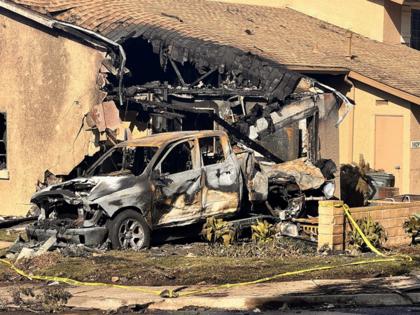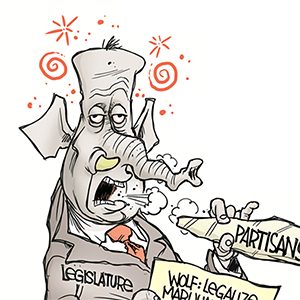Fatal crash raises questions about proximity of airports to homes and businesses
Published in News & Features
SAN DIEGO — It’s 540 acres of runways and hangars and flying schools surrounded on all sides by sprawling San Diego neighborhoods that attract thousands of pilots every year.
And now, after six people were killed and more than a dozen homes were heavily damaged in the fiery crash of a private jet on its approach to Montgomery-Gibbs Executive Airport early Thursday, the city-owned landing field is under scrutiny yet again.
Investigators are still working to figure out what caused the Cessna 550 Citation II to plunge into a cluster of military family homes in the Murphy Canyon area of Tierrasanta, east of the general aviation airport.
But the fatal accident has reignited safety concerns about Montgomery-Gibbs, where so many homes and businesses sit beneath its popular flight paths.
“It is crazy to have a private airport with rookie pilots flying around, training pilots in a heavily urbanized area,” said Jack McGrory, the former San Diego city manager who previously sought to rezone the property.
“These planes should be flying down at Brown Field or out of Gillespie, which is less populated,” McGrory said. “But Montgomery Field should be closed — and it should have been closed a while ago.”
San Diego city spokesperson Tara Lewis said officials have worked diligently to make sure the airport is safe for pilots, passengers and nearby residents.
“Safety is the city’s utmost priority and is achieved through compliance with regulations, procedures and education,” she said by email. “The Montgomery-Gibbs Executive Airport conducts frequent inspections for the integrity and security of the airport.”
Lewis said airport staff, pilots and regulators meet annually to review operations, and newcomers to the facility have access to a webpage with details on the airport.
The 3:45 a.m. crash wreaked havoc across several blocks of federal housing, leaving smashed cars and a trail of jet fuel burning in the street. More than 10 houses were badly damaged from debris, sending shocked families running from the smoke and flames.
Some operations at the airfield were not fully functioning as the pilot nursed the business jet toward its landing, according to Dan Baker, the National Transportation Safety Board investigator in charge of the case.
The accident occurred in a dense fog, and the automated weather system designed to update pilots to local conditions was not functioning due to an earlier power surge, federal officials said. Instead, the pilot relied on the weather report from nearby Marine Corps Air Station Miramar, about 4 miles away.
Two of the field’s approach lighting systems for the runway, which help to direct a pilot on the correct glide slope and to line up with the runway, were also down, and had been since October. Pilots checking for any “notice to airmen,” or NOTAM, at the airport would have seen word of the outage.
The airport’s air traffic control tower, which is operated from 6 a.m. to 9 p.m. daily, was not staffed, meaning the pilot had to announce his position and intent to other pilots who may be in the area. His last transmission was an announcement that he was three miles out on final approach. He did not report any emergency or mechanical issues before crashing, Baker said.
Federal investigators have yet to issue any conclusive findings on what went wrong or if any of those airport factors contributed to the crash — an initial assessment is due within 30 days, and a final report generally takes one to two years to complete.
“The FAA, under a memorandum of understanding with the city of San Diego, owns and is responsible for the maintenance of navigational aid facilities, weather facilities, communication facilities and approach lighting systems,” Lewis said Friday when asked about the inoperable systems.
Other runway lighting systems were operable at the time of the crash, she said.
World War II training ground
Montgomery-Gibbs dates back to 1937, when a single runway provided pilots and pilots-in-training a place to perform their craft.
The airfield famously hosted an aeronautical school in the 1940s, when the Army Air Corps relied on the facility to train aviators headed off to fight World War II. The city purchased the property from founder William Gibbs soon after the war ended.
But the Kearny Mesa plateau is far different today.
Thousands of homes and businesses have been built in every direction from what for years was called Montgomery Field in honor of John J. Montgomery, the pioneer aviator credited with completing the first fixed-wing flight in the early 20th century.
By 2004, a city task force was looking at the airfield for affordable housing.
But city officials rejected the idea, saying the aviation community relied on the facility. Instead, San Diego poured millions of dollars into Montgomery Field and Brown Field, the other city-owned airport just north of the U.S.-Mexico border.
The investment worked.
Montgomery Field today is one of the busiest general-aviation airports in California. By 2019, some 250,000 takeoffs or landings were recorded. Over the past 12 months, the airport has seen more than 386,000.
The growth has not come without incident, however.
Including the Murphy Canyon crash, there have been six deadly accidents involving planes flying in or out of the Kearny Mesa airport since 2015.
Over the prior 15 years, just two fatal incidents were reported. Montgomery-Gibbs also recorded 25 safety incidents in the past 10 years, a notable increase over the 16 events reported in the prior decade.
All but one of the last six fatal crashes at Montgomery-Gibbs involved either a student pilot, poor visibility or an impact on a residential neighborhood.
The possibility of pilot error
While investigators determine the cause of Thursday’s accident, aviation experts said the Kearny Mesa airport was not likely to blame for what happened.
Michael Henderson, who frequently serves as an expert witness in aviation litigation, said early clues indicate the crash was most likely due to pilot error, from undertaking a late-night cross-country flight to proceeding with a landing with such poor visibility.
“This has got nothing to do with the airport,” Henderson said. “This has got to do with the entire flight.”
Public flight data also raise questions about the pilot’s decision-making.
According to FlightAware.com, which tracks the movement of aircraft, the Cessna 550 made multiple diversions from its registered flight path, including one over the Anza-Borrego Desert State Park and during its final approach.
Data indicate the pilot descended too low, clipping a power transmission line before going down.
“The crux of it was that the pilot flew too low,” said aviation expert Max Trescott. “He flew down to about 500 feet, which is 173 feet below the minimums for that approach.”
Experts also questioned why the pilot, presumed to be music agent David Shapiro, even attempted the cross-country journey from New Jersey overnight with only a 45-minute stop for fuel in Kansas.
“He did something wrong,” Henderson said. “The fact he tried to do this flight in one shot, he should have stayed (in Wichita) and gotten some sleep.”
Trescott, who hosts the Aviation News Talk podcast, said the terrain surrounding Montgomery-Gibbs is not particularly dangerous. It stands at about 400 feet above sea level and has only one runway available to pilots landing at night.
“The real issues come with field elevations that are 4,000 feet and 6,000 feet,” Trescott said. “I don’t know of any unusual risks with Montgomery Field.”
_______
©2025 The San Diego Union-Tribune. Visit sandiegouniontribune.com. Distributed by Tribune Content Agency, LLC.







Comments